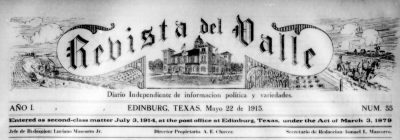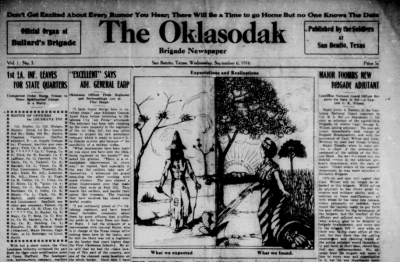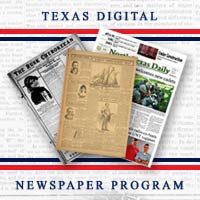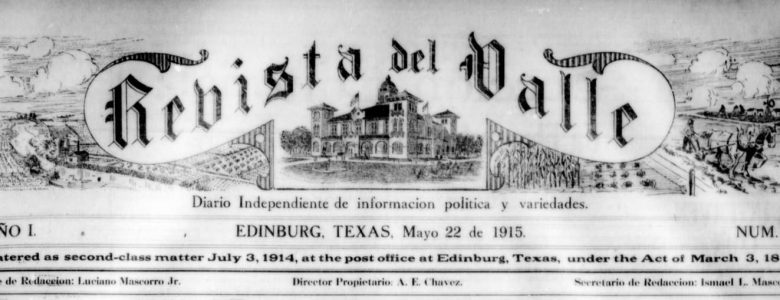This blog post features work written by Redd Howard about the Oklasodak newspaper. Originally from McKinney, Texas, Redd is one of our student assistants in the Digital Newspaper Unit, studying as an Art History major and French minor. Redd is also an undergraduate research fellow in Art History at UNT, working with Dr. Jennifer Way. Following graduation, Redd would like to pursue graduate studies in Art History and Library Science, with the goal of working as an archivist or librarian in museum collections. The Newspaper Unit’s Sarah Lynn Fisher collaborated with Redd in locating and writing about these gems of history.
The Borderlands Newspaper Collection, digitized through the support of a TexTreasures grant from the Institute of Museum and Library Services (IMLS) and the Texas State Library and Archives Commission (TSLAC), now includes newspaper titles from counties previously not represented in the Texas Digital Newspaper Program (TDNP), including Kleberg, Kinney, Kimble, Pecos, Uvlade, Brooks, and Reeves counties. Some newspapers in this collection are very unique and have drawn our research curiosity.
One of these unique titles is Revista Del Valle, a daily Spanish-language newspaper published in Edinburg, Texas, the county seat of Hidalgo County in southern Texas. A brief but historically-significant collection of issues of Revista Del Valle from the year 1915 is now available on the Portal. According to the Texas State Historical Association’s Handbook of Texas Online, 1915 was the year that the arrival of irrigation transformed the region from a ranching community to the major agricultural region that it is today. The importance of farming in the region is reflected in Revista Del Valle’s ornate masthead. However, much of the reporting in these issues is devoted to the “Borderlands War” conflict, an undeclared period of conflict along the Texas-Mexico border that coincided with the Mexican Revolution, which is often overshadowed by World War I in the historical record. As the railroad brought more settlers to the region, landowners of Mexican descent were often displaced “using unscrupulous and often illegal tactics”. This led to resentment, racial tension, and ultimately extreme violence on both sides. This editorial from May 11, 1915 illustrates the urgency of a region and a world in conflict and advises against participation in future wars.
the year 1915 is now available on the Portal. According to the Texas State Historical Association’s Handbook of Texas Online, 1915 was the year that the arrival of irrigation transformed the region from a ranching community to the major agricultural region that it is today. The importance of farming in the region is reflected in Revista Del Valle’s ornate masthead. However, much of the reporting in these issues is devoted to the “Borderlands War” conflict, an undeclared period of conflict along the Texas-Mexico border that coincided with the Mexican Revolution, which is often overshadowed by World War I in the historical record. As the railroad brought more settlers to the region, landowners of Mexican descent were often displaced “using unscrupulous and often illegal tactics”. This led to resentment, racial tension, and ultimately extreme violence on both sides. This editorial from May 11, 1915 illustrates the urgency of a region and a world in conflict and advises against participation in future wars.
 The Oklasodak, another unique title in the Borderlands collection, is a 1916-1917 “newspaper of the soldiers, for the soldiers, and by the soldiers” published by National Guardsmen from the states of Louisiana, South Dakota, and Oklahoma. Perhaps in response to the unrest along the border, the troops were stationed in San Benito, Texas under the leadership of Colonel Robert Lee Bullard, and eventually were called the Bullard’s Brigade. The newspaper was first published on August 25, 1916, and ran until February 7, 1917. The last edition stated its early and abrupt suspension due to an order for the soldiers to return to their respective homes. In the 24 published issues of the regimental newspaper, many segments include geographical and social challenges of life in a border town. The reoccurring segments, “Life of the Soldier” and “Health of the Soldier,” provided general advice to these challenges.
The Oklasodak, another unique title in the Borderlands collection, is a 1916-1917 “newspaper of the soldiers, for the soldiers, and by the soldiers” published by National Guardsmen from the states of Louisiana, South Dakota, and Oklahoma. Perhaps in response to the unrest along the border, the troops were stationed in San Benito, Texas under the leadership of Colonel Robert Lee Bullard, and eventually were called the Bullard’s Brigade. The newspaper was first published on August 25, 1916, and ran until February 7, 1917. The last edition stated its early and abrupt suspension due to an order for the soldiers to return to their respective homes. In the 24 published issues of the regimental newspaper, many segments include geographical and social challenges of life in a border town. The reoccurring segments, “Life of the Soldier” and “Health of the Soldier,” provided general advice to these challenges.
In one of the “Health of the Soldier” segments from the November 8, 1916 issue, Captain W. S. Shields, the camp sanitary investigator, informs the soldiers about the harmful–and often deadly–illnesses of the native population of Tampico, Mexico, including malaria and tuberculosis. In the January 3, 1917 issue, the article, “Mexican Vote Puts Town Wet,” shows some of the clashing interests or ideologies of the American soldiers and the Mexican citizens during the period. The American soldiers desired a dry city to practice obedience, attention, and initiative. However, the wet vote beat the dry vote 265 to 215.
The Oklasodak is a great addition to the Texas Borderlands Newspaper Collection. It shows a brief moment in history of the daily life in borderland and provides insight into the lives of American soldiers in the early 20th century.
 |
 |
 |

